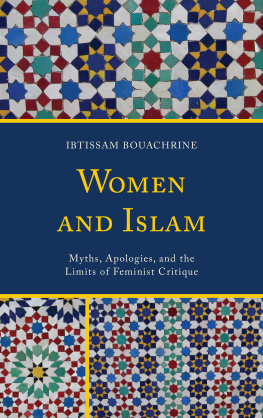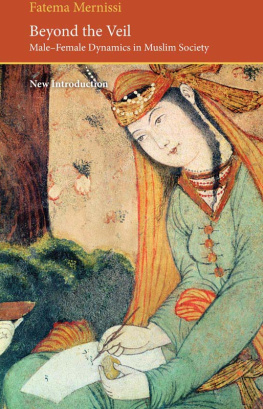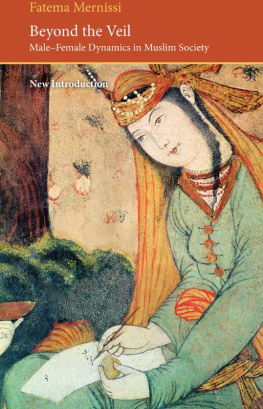Women and Islam
Women and Islam
Myths, Apologies, and the Limits
of Feminist Critique
Ibtissam Bouachrine
LEXINGTON BOOKS
Lanham Boulder New York Toronto Plymouth, UK
Published by Lexington Books
A wholly owned subsidiary of Rowman & Littlefield
4501 Forbes Boulevard, Suite 200, Lanham, Maryland 20706
www.rowman.com
10 Thornbury Road, Plymouth PL6 7PP, United Kingdom
Copyright 2014 by Lexington Books
All rights reserved. No part of this book may be reproduced in any form or by any electronic or mechanical means, including information storage and retrieval systems, without written permission from the publisher, except by a reviewer who may quote passages in a review.
British Library Cataloguing in Publication Information Available
Library of Congress Cataloging-in-Publication Data
Bouachrine, Ibtissam.
Women and Islam : myths, apologies, and the limits of feminist critique / Ibtissam Bouachrine.
p. cm.
Includes bibliographical references and index.
ISBN 978-0-7391-7906-2 (cloth) ISBN 978-0-7391-7907-9 (electronic)
1. Women in Islam. 2. FeminismReligious aspectsIslam. I. Title.
BP173.4.B68 2014
297.082dc23
2014010403
 TM The paper used in this publication meets the minimum requirements of American National Standard for Information Sciences Permanence of Paper for Printed Library Materials, ANSI/NISO Z39.48-1992.
TM The paper used in this publication meets the minimum requirements of American National Standard for Information Sciences Permanence of Paper for Printed Library Materials, ANSI/NISO Z39.48-1992.
Printed in the United States of America
For Hayate al-Noufous El-Hajjali and Bouchaib Bouachrine
Acknowledgments
This book owes much to the rich intellectual community at Smith College. I owe particular debts of gratitude to Kenneth Stow for his support of my work and for his critical guidance. Many thanks to the entire Spanish and Portuguese Department and Middle East Studies Program especially Estela Harretche, Marguerite Harrison, Reyes Lzaro who have been sources of inspiration. This book could not have been written without the generous mentoring of the strong feminists at Smith, Donna Divine and Pamela Petro, to name a few.
I am also profoundly grateful to the many mentors I have had throughout my life. At West Virginia University, Judith Gold Stitzel and Kathleen McNerney introduced me to the study of women and gender. At Florida State University, Santa Arias challenged me to explore premodern history with a feminist eye. At Tulane University, Jean Dangler inspired my career.
I have often relied on the support of good friends in times of self-doubt. I thank them for their valuable insight, encouragement, and friendship: Yoel Ohayon, Idelber Avelar, and Rabbi Justin David. Douglas Lane Patey and Anouar Majid encouraged me to think critically beyond the sacred. My office neighbor Payal Banerjee reminded me that laughter, pleasure, and feminism go together. I am equally indebted to the audiences at the universities where I was invited to share my ideas early on: University of Massachusetts in Amherst, Harvard University, the Catalan Center at New York University, and Institut National des Langues et Civilisations Orientales. I thank Claire Huttlinger for her keen editorial eye and for her rigorous standards. I also thank the editors at Lexington Books, especially Sarah Ghulamali, Justin Race and Brian Hill for believing in this book from the beginning and for supporting me at every stage of this project.
Beyond these debts, I wish to thank all my students at Smith College. Thank you for indulging me while I made the case for Lil Wayne in the study of the Mediterranean. Special thanks to Elizabeth (Bethy) Williams, who was invaluable as my research assistant during a crucial stage of the project.
An earlier version of a portion of Chapter 1 appeared as In the Absence of Men: Representing Andalusi Womens Sexuality in the Context of Military Conflict, Journal of Medieval Iberia 4, 1 (2012) (www.tandfonline.com); an earlier version of a portion of Chapter 5 appeared in French as Rjal et leurs reines: Le printemps arabe et le discours sur la masculinit et la fminit, NAQD: Revue dEtudes et de Critique Sociale 29 (2012); an earlier version of a portion of Chapter 2 appeared as Zoraida, the Other Author of the Quixote, Al-Masar Journal 13 (2012). All are reproduced with permission of the editors and publishers. The completion of this study was facilitated by generous grants from the Provosts Office at Smith College and a summer seminar grant from the National Endowment for the Humanities. For this support, I am truly thankful.
Last, but not least, I thank my brother, Tachfine Bouachrine, for his love, encouragement, and belief in this project, and my sister, Hind Bouachrine, who has influenced this book right from its inception and read it in its numerous incarnations. Finally, I owe my greatest debt to my parents, Hayat al-Noufous El-Hajjali and Bouchaib Bouachrine, who made great sacrifices to educate me even when they were advised against investing so much in a womans intellect. It is to them that I dedicate this book, with love, admiration, and gratitude.
Introduction
On Saturday, March 10, 2012, sixteen-year-old Amina Filali killed herself after she was severely beaten by her husband, who had also raped her. Under Article 475 of the Moroccan penal code, a rapist is allowed to marry his victim in order to avoid prosecution. Fearing public humiliation and the stigma of no longer being a virgin, Filali was forced to marry the man who had raped her at age fifteen, and who continued to abuse her physically throughout their marriage. When she realized that neither the law nor society could be invoked to rescue her, she committed suicide by swallowing rat poison.
On Saturday, March 17, 2012, thirty-three-year-old Fakhra Younus jumped from a sixth-floor window in Rome, Italy. Twelve years earlier, her ex-husband, a Pakistani man from a wealthy and prominent family, had attacked her with acid. She underwent thirty-nine separate surgeries to reconstruct her face and body. When she could no longer bear the pain and injustice, she too killed herself.
In July 2012, a twenty-two-year-old Afghani woman identified as Najibia was executed in Parwan Province in front of a cheering crowd. The brutal event was captured in an amateur three-minute video. Her alleged crime was adultery.
Though they may appear to be extreme, these are not isolated stories. Muslim women of all ages, economic status, educational backgrounds, sexual orientations, and from different parts of historically Muslim countries, suffer the kinds of atrocities that not only violate common understandings of human rights and normally denounced as criminal or pathological and yet are sustained because they uphold some religious doctrine or some custom blessed by local traditions. Ironically, while instances of abuse meted out to women and even female children are routine, scholarship about Muslim women in the post 9/11 era has rarely focused attention on them preferring to speak of womens agency and resistance. Too few scholars are willing to tell the actual complicated and at times harrowing stories of Muslim women's lives. Women and Islam: Myths, Apologies, and the Limits of Feminist Critique radically rethinks the celebratory discourse constructed around Muslim womens resistance. It shows instead the limits of such resistance and the restricted agency given women within Islamic societies. The first chapters concentrate on pre-modern sources, although the book as a whole does not center on a single historical period. Rather, it is organized as a response to five questions that have been central to upholding the 'resistance discourse': What is the impact of the myth of al-Andalus on a feminist critique? What is the feminist utility of Edward Saids theory of Orientalism? Is Islam compatible with a feminist agenda? To what extent can Islamic institutions, such as the veil, be liberating for women? Will the current Arab uprisings yield significant change for Muslim women?
Next page





 TM The paper used in this publication meets the minimum requirements of American National Standard for Information Sciences Permanence of Paper for Printed Library Materials, ANSI/NISO Z39.48-1992.
TM The paper used in this publication meets the minimum requirements of American National Standard for Information Sciences Permanence of Paper for Printed Library Materials, ANSI/NISO Z39.48-1992.